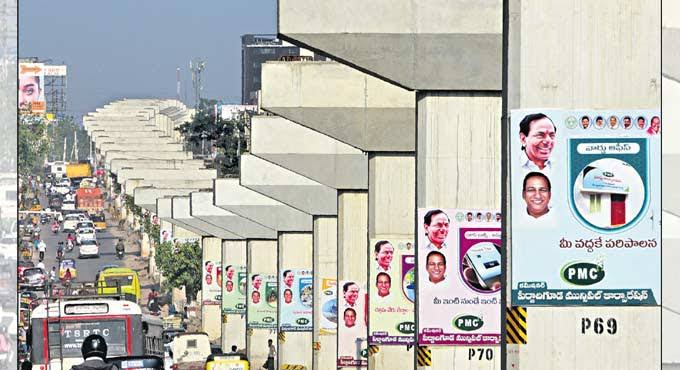Hyderabad, Telangana – For residents and commuters traversing through Uppal, the daily commute has long been synonymous with frustrating traffic snarls and arduous delays. This critical eastern gateway to the city, connecting Hyderabad to destinations like Warangal and Yadadri-Bhuvanagiri, is a constant choke point, a situation significantly aggravated by the inordinate delays in the construction of the Uppal-Ghatkesar elevated corridor (often referred to as the Uppal-Narapally flyover).
The Perennial Traffic Woes of Uppal
Uppal Junction is a crucial intersection, serving as a convergence point for multiple routes. The sheer volume of vehicles, including RTC buses and private vehicles heading towards Warangal and surrounding districts, overwhelms the existing road infrastructure, particularly during peak hours. Commuters frequently report extended travel times, sometimes adding an hour or more to their journey.
The reasons for this perpetual gridlock are multifaceted:
* High Vehicular Density: Uppal’s strategic location means it handles a massive influx and outflow of traffic daily.
* Narrow Roads: Despite its importance, sections of the road infrastructure in Uppal remain relatively narrow, unable to cope with the heavy traffic.
* Construction-Related Bottlenecks: The ongoing flyover construction itself creates significant bottlenecks. Diversions, reduced road widths, and the presence of construction machinery contribute directly to congestion.
* Poor Road Conditions: Sections of the road, particularly those impacted by the long-standing construction, are often plagued by potholes and dust, further slowing down traffic and making the commute hazardous.
* IPL Matches: On days when IPL matches are held at the Rajiv Gandhi International Cricket Stadium in Uppal, the area experiences severe traffic diversions and restrictions, turning an already difficult situation into a near-standstill.
The Elephant in the Room: The Delayed Uppal-Ghatkesar Flyover
The Uppal-Ghatkesar elevated corridor is a six-lane, 6.25-kilometer project envisioned to be the second-longest flyover in Telangana (after the PV Narasimha Rao Expressway). It was launched with much fanfare in May 2018, with an initial completion target of June 2020. However, nearly seven years later, the project remains far from complete, with reports indicating only around 40% of the work has been finished by mid-2023 and early 2025.
The reasons for this prolonged delay are a source of considerable public frustration and have been attributed to:
* Land Acquisition Issues: Acquiring the necessary land, particularly near Nalla Cheruvu, has been a significant hurdle. Reports suggest that land acquisition, even after years, is not entirely complete, leading to project stalls.
* Contractor Problems and Funding Issues: There have been reports of contractor funding issues, underbidding, and inefficient contractors. In fact, Union Minister Nitin Gadkari reportedly ordered the termination of the previous contractor and called for fresh tenders in June 2024 due to the slow pace of work.
* Utility Relocation Delays: The shifting of water pipes, sewer lines, and electric poles proved to be a major time-consuming task, with accusations of poor coordination and negligence by the previous state government. The central government has reportedly even imposed a fine on the state for delays in utility relocation.
* Lack of Proper Monitoring and Coordination: Political blame games between the state and central governments have also emerged, with each side accusing the other of negligence and lack of cooperation in expediting the project.
* Cost Escalation: The initial estimated cost of the project was around Rs 600-675 crore. However, due to the protracted delays, the cost has inevitably escalated, with new tenders likely requiring an additional Rs 200-300 crore.
The Impact on Commuters and the Environment
The ongoing delays have turned the Uppal stretch into a dust bowl, particularly for those commuting from Warangal and Yadadri-Bhuvanagiri. The combination of bad roads, construction debris, and constant vehicle movement leads to significant air and noise pollution, impacting the health and well-being of residents and daily commuters. The psychological toll of being stuck in perpetual traffic jams is also considerable.
The Way Forward
While various assurances have been given, including a promise from the R&B Minister in August 2024 that the flyover would be completed in 18 months, and a fresh target of 30 months by May 2025, the public remains skeptical. For the situation to improve, a concerted effort is required, focusing on:
* Expedited Land Acquisition: Resolving the remaining land acquisition issues swiftly is paramount.
* Efficient Contractor Management: Ensuring that the new contractor (once finalized) is competent and adheres to strict timelines.
* Inter-Departmental Coordination: Seamless coordination between various government departments (R&B, GHMC, Water Board, Electricity Board) is crucial for utility shifting and other related works.
* Regular Monitoring and Accountability: Stringent oversight and accountability for project progress are essential to prevent further slippages.
Until the Uppal-Ghatkesar flyover is finally completed, the residents and commuters of Hyderabad’s eastern corridor will continue to face a daily ordeal, hoping for a swift resolution to this long-pending infrastructure project.

